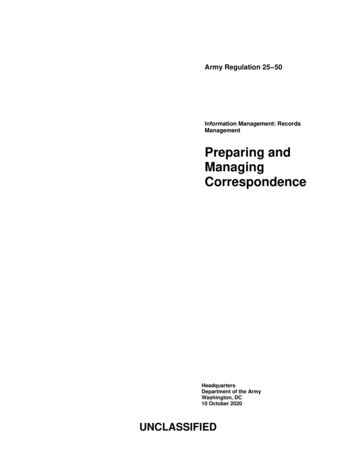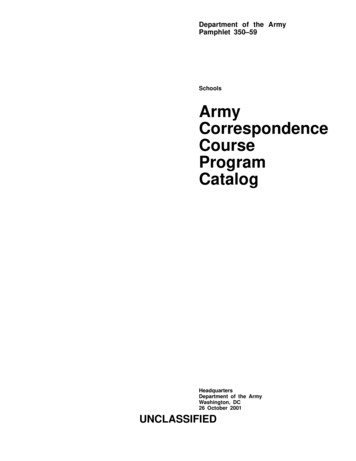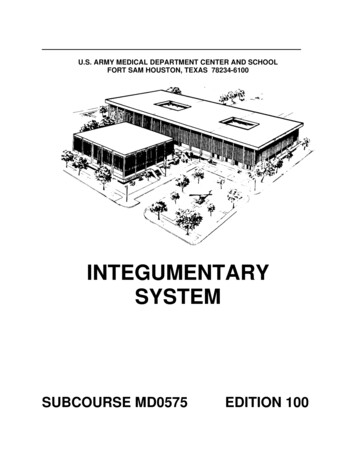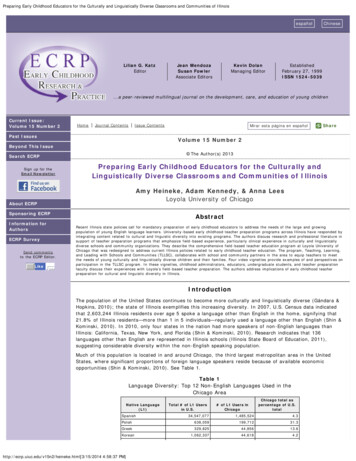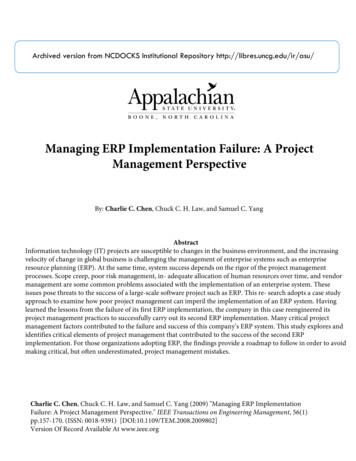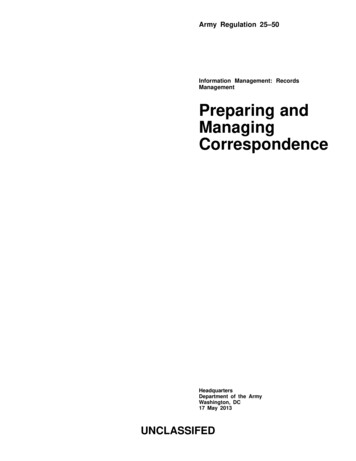
Transcription
Army Regulation 25–50Information Management: RecordsManagementPreparing andManagingCorrespondenceHeadquartersDepartment of the ArmyWashington, DC17 May 2013UNCLASSIFED
SUMMARY of CHANGEAR 25–50Preparing and Managing CorrespondenceThis administrative revision, dated 6 July 2015-oMakes administrative changes to paragraph text (paras 3-6c, 6-5c, and 65c(8)).oMakes administrative changes to table text (table C-4).oMakes administrative changes to figures (figs 3-1 and D-7).oRemoves acronym “standing operating procedure” from the abbreviationssection (glossary).This major revision, dated 17 May 2013-oTransfers proponency for the Army’s correspondence program from the DeputyChief of Staff, G-1 to the Administrative Assistant to the Secretary of theArmy (para 1-4a).oAllows for the use of Army Knowledge Online and Defense Knowledge Onlineinstant messaging for organizational and individual information transfer(para 1-7e).oAdds policy to capitalize “Soldier” for internal Army correspondence (para 113a).o Adds policy to capitalize “Family” for internal Army correspondence (para 113b).oAdds policy to capitalize “Civilian” for internal Army correspondence whenreferring to U.S. Department of the Army civilians and used in conjunctionwith Soldier and/or Family (para 1-13c).oChanges preferred font to Arial, point size 12 (paras 1-17a and 1-17b).oAllows for the use of courtesy copy on letters (para 1-19d).oAdds reference to Public Law 111-274 (Plain Writing Act of 2010) (paras 1-10and 1-36a).oAllows for the optional use of Army Records Information Management Systemrecord numbers after the office symbol on Army correspondence (para 2-4a(2)).oRevises policy on reducing cost and expediting distribution of official mail(chap 5).oStandardizes signature blocks for all retired military personnel (para 6-6).oMakes administrative changes (throughout).
*Army Regulation 25–50HeadquartersDepartment of the ArmyWashington, DC17 May 2013Effective 17 June 2013Information Management: Records ManagementPreparing and Managing CorrespondenceStates, and the U.S. Army Reserve, unlessotherwise stated.History. This publication is anadministrative revision. The portionsaffected by this administrative revision arelisted in the summary of change.Summary. This regulation establishesthree forms of correspondence authorizedfor use within the Army: a letter, a memorandum, and a message.Applicability. This regulation applies tothe Active Army, the Army NationalGuard/Army National Guard of the UnitedContentsProponent and exception authority.The proponent of this regulation is theAdministrative Assistant to the Secretaryof the Army. The proponent has the authority to approve exceptions or waiversto this regulation that are consistent withcontrolling law and regulations. The proponent may delegate this approval authority, in writing, to members of the SeniorExecutive Service within the proponentagency. Activities may request an exception or waiver to this regulation by providing justification that includes a fullanalysis of the expected benefits and aformal review by the activity’s seniorlegal officer. All requests for exceptionsor waivers will be endorsed by the commander or senior leader of the requestingactivity and forwarded through theirhigher headquarters to the proponent. Refer to AR 25–30 for specific guidance.Army internal control process. Thisregulation contains internal control provisions and provides an internal controlevaluation for use in evaluating key internal controls (see appendix F).Supplementation. Supplementation ofthis regulation and establishment of command or local forms are prohibited without prior approval from theAdministrative Assistant to the Secretaryof the Army (SAAA), 105 Army Pentagon, Washington, DC 20310–0105.Suggested improvements. Users areinvited to submit comments and suggestedimprovements on DA Form 2028 (Recommended Changes to Publications andBlank Forms) directly to U.S. Army Records Management and DeclassificationAgency, Records Management Division(AAHS–RDR–C), 7701 Telegraph Road,Alexandria, VA 22315–3860.Distribution. This publication is available in electronic media only and is intended for command levels A, B, C, D,and E for the Active Army, the ArmyNational Guard/Army National Guard ofthe United States, and the U.S. ArmyReserve.(Listed by paragraph and page number)Chapter 1Preparing Correspondence, page 1Section IGeneral, page 1Purpose 1–1, page 1References 1–2, page 1Explanation of abbreviations and terms 1–3, page 1Responsibilities 1–4, page 1Restrictions to this regulation 1–5, page 1Objectives 1–6, page 1Section IIGeneral Correspondence Guidance, page 1*This regulation supersedes AR 25–50, dated 3 June 2002.AR 25–50 17 May 2013UNCLASSIFIEDi
Contents—ContinuedMethods of communication 1–7, page 1Direct communications 1–8, page 2Routing through channels 1–9, page 2Writing quality 1–10, page 2Exclusive For correspondence 1–11, page 2Section IIISpecific Correspondence Guidance, page 2Dissemination of command instructions 1–12, page 2Unique capitalization 1–13, page 2Abbreviations, brevity codes, and acronyms 1–14, page 2Letterhead 1–15, page 3Paper 1–16, page 3Type fonts and sizes 1–17, page 3Ink color 1–18, page 3Copies 1–19, page 3Classified and special handling correspondence 1–20, page 3Identifying a point of contact 1–21, page 4Identifying the originating office 1–22, page 4Expressing a date 1–23, page 4Expressing time 1–24, page 4Suspense date 1–25, page 4Addressing 1–26, page 4Postscripts 1–27, page 4References 1–28, page 4Page and paragraph numbering 1–29, page 5Using boldface and italic type for emphasis 1–30, page 5Distribution formulas 1–31, page 5Identifying and listing enclosures 1–32, page 5Nine-digit ZIP code (ZIP 4 code) 1–33, page 5North Atlantic Treaty Organization correspondence 1–34, page 5Recordkeeping requirements for delegations of signature authority 1–35, page 5Section IVEffective Writing and Correspondence: The Army Writing Style, page 6Standards for Army writing 1–36, page 6Constructing military correspondence 1–37, page 6Chapter 2Preparing Memorandums, page 6General 2–1, page 6Use 2–2, page 6General rules 2–3, page 6Format 2–4, page 7Multiple-page memorandums 2–5, page 8Memorandum of understanding or memorandum of agreement 2–6, page 8Memorandum for record 2–7, page 9Chapter 3Preparing Letters, page 32General 3–1, page 32Use 3–2, page 32Response phrases 3–3, page 32Abbreviations 3–4, page 32General rules 3–5, page 32iiAR 25–50 17 May 2013
Contents—ContinuedFormat 3–6, page 32Chapter 4Listing Enclosures, Placing Tabs, and Assembling Correspondence, page 40General 4–1, page 40Enclosures 4–2, page 40Tabbing enclosures 4–3, page 41Tabbing correspondence packages 4–4, page 41Chapter 5Processing Correspondence and Official Mail, page 43Section ICost Reduction Methods, page 43Reducing mail costs 5–1, page 43Disseminating correspondence via messenger envelopes 5–2, page 43Section IIEnvelopes, page 43Size 5–3, page 43Folding and fastening 5–4, page 43Preparing envelopes for mailing 5–5, page 43Address locations on larger than letter-sized (flat) mail 5–6, page 44Section IIIAddressing Mail, page 44Delivery address 5–7, page 44Return address 5–8, page 45Addressing 5–9, page 45Address format 5–10, page 45Address content 5–11, page 46“To the Commander of ” 5–12, page 47Chapter 6Preparing Authority Lines, Signatures, and Signature Blocks, page 48Section IDelegation of Authority, page 48Delegation of signature authority 6–1, page 48Delegation of authority line 6–2, page 48Section IISignatures and Signature Blocks, page 49Signatures 6–3, page 49Signature block 6–4, page 49Personnel on active duty 6–5, page 51Retired military personnel 6–6, page 52Army Reserve personnel not on active duty 6–7, page 52Civilian personnel and contract surgeons 6–8, page 52Signatures of subordinates 6–9, page 52Auto-pen signature 6–10, page 52Addressing retired military 6–11, page 53Chapter 7Using Prescribed Forms and Labels, page 53General 7–1, page 53AR 25–50 17 May 2013iii
Contents—ContinuedRouting and transmittal slips 7–2, page 53Department of the Army Form 5 7–3, page 53Department of the Army Form 200 7–4, page 53Department of the Army Form 209 7–5, page 53Department of the Army Label 87 7–6, page 53Department of the Army Label 113 7–7, page 53Department of the Army Label 115 7–8, page 53Optional Form 65–B 7–9, page 54Optional Form 65–C 7–10, page 54Chapter 8Marking Classified Correspondence, page 54General authority 8–1, page 54Guidance on markings 8–2, page 54Cover sheets 8–3, page 54AppendixesA.References, page 64B.Titles and Protocol Sequence, page 66C.Forms of Address, Salutation, and Complimentary Close, page 68D.Model Authority Lines and Signature Blocks, page 84E.Preparing Mass Mailings, page 93F.Internal Control Evaluation, page 94Table ableTable5–1: Address format, page 445–2: Optional line, page 445–3: Delivery address line, page 445–4: Foreign mail, page 455–5: Return address, page 455–6: Completeness and accuracy, page 465–7: USPS two-letter State or territory abbreviations, page 465–8: Example of “To the Commander of ”, page 486–1: Grade abbreviations, page 506–2: Branch title abbreviations, page 50C–1: The Executive Branch, page 69C–2: The Congress and legislative agencies, page 71C–3: The Judiciary, page 73C–4: Military personnel, page 74C–5: State and Government officials, page 77C–6: Ecclesiastical officials, page 79C–7: Private citizens, page 81C–8: Corporations, companies, and federations, page 82C–9: Foreign government officials, page 82C–10: International organizations, page 82C–11: Addressing former officials, page 84Figure ��3:Using and preparing a memorandum, page 10Preparing a memorandum with a suspense date, page 11Preparing a memorandum with a suspense date (continued), page 12Addressing a single-address Headquarters, Department of the Army memorandum, page 13AR 25–50 17 May 2013
Contents—ContinuedFigure 2–4: Addressing a single-address Army service component command memorandum, page 14Figure 2–5: Addressing a multiple-address memorandum for Headquarters, Department of the Army agencies usingfull titles and addresses, page 15Figure 2–6: Addressing a multiple-address memorandum for Headquarters, Department of the Army agencies usingoffice symbols, page 16Figure 2–7: Addressing an Army command multiple-address memorandum, page 17Figure 2–8: Preparing a SEE DISTRIBUTION addressed memorandum, page 18Figure 2–8: Preparing a SEE DISTRIBUTION addressed memorandum (continued), page 19Figure 2–9: Preparing a DISTRIBUTION list on the second page, page 20Figure 2–9: Preparing a DISTRIBUTION list on the second page (continued), page 21Figure 2–10: Preparing a memorandum with a distribution formula, page 22Figure 2–11: Preparing a single-address MEMORANDUM THRU, page 23Figure 2–12: Preparing a MEMORANDUM THRU with two addresses, page 24Figure 2–13: Preparing a one-paragraph memorandum with subparagraphs and continuing the subject line, page 25Figure 2–14: Listing enclosures, copies furnished, and point of contact paragraph, page 26Figure 2–15: Preparing a memorandum of understanding, page 27Figure 2–15: Preparing a memorandum of understanding (continued), page 28Figure 2–16: Preparing a memorandum of agreement, page 29Figure 2–16: Preparing a memorandum of agreement (continued), page 30Figure 2–17: Preparing a memorandum for record, page 31Figure 3–1: Formatting a letter, page 34Figure 3–1: Formatting a letter (continued), page 35Figure 3–2: Using office symbols and titles, page 36Figure 3–3: Spacing in a letter, page 37Figure 3–4: Preparing a letter with a subject line, page 38Figure 3–5: Using courtesy copy in letters, page 39Figure 4–1: Capitalizing the first letter in the first word of a listed enclosure, page 40Figure 4–2: Accounting for enclosures not identified in the body of the correspondence, page 40Figure 4–3: Having one enclosure that is not identified in the body, page 40Figure 4–4: Having enclosures without a number preceding Encl/Encls, page 40Figure 4–5: Using approved abbreviations, page 41Figure 4–6: Identifying some enclosures but not others, page 41Figure 4–7: Tabbing correspondence, page 42Figure 8–1: Marking the security classification of portions, page 55Figure 8–1: Marking the security classification of portions (continued), page 56Figure 8–2: Preparing a restricted data additional warning notice memorandum, page 57Figure 8–2: Preparing a restricted data additional warning notice memorandum (continued), page 58Figure 8–3: Preparing a formerly restricted data additional warning notice memorandum, page 59Figure 8–3: Preparing a formerly restricted data additional warning notice memorandum (continued), page 60Figure 8–4: Marking unclassified transmittal documents, page 61Figure 8–5: Marking classified transmittal documents, page 62Figure 8–6: Marking classified working papers, page 63Figure B–1: Addressing the Office of the Secretary of Defense, page 67Figure B–2: Addressing Headquarters, Department of the Army principal officials, page 68Figure D–1: Signed by the commanding general of a command, page 85Figure D–2: Signed by an authorized subordinate of the commander, page 85Figure D–3: Signed by the head of a Headquarters, Department of the Army Staff agency, page 86Figure D–4: Signed by an authorized representative of a Headquarters, Department of the Army staff agency,page 86Figure D–5: Signed by the commanding officer of a unit, headquarters, or installation, page 86Figure D–6: Signed by an authorized representative of the commander of a unit, headquarters, or installation,page 87Figure D–7: Signed by an authorized representative f
referring to U.S. Department of the Army civilians and used in conjunction with Soldier and/or Family (para 1-13 c). o Changes preferred font to Arial, point size 12 (paras 1-17 a and 1-17 b). o Allows for the use of courtesy copy on letters (para 1-19 d). o Adds reference to Public Law 111-274 (Plain Writing Act of 2010) (paras 1-10 and 1-36 a).
